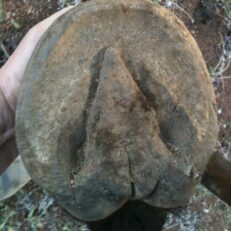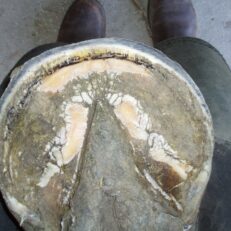BAREFOOT BLUNDER – OR MISINTERPRETATION OF MOTHER NATURE’S RULES?
The first photo shows the end result after 18 months of regular attendance by a barefoot trimmer.
My involvement came by way of the owner’s search for answers to explain why all of her six horses were unsound for working. The history was that her horses were worked without shoes and were sound, regularly trimmed by an experienced farrier who had retired 18 months before, and it was then that their hoof soundness began to deteriorate. When I received this photo which was representative of the status of all her horses’ hooves, it was very easy to see where it was going wrong.
In fairness, this was a bad barefoot trim, and like farrier trims they can vary considerably as there are so many different barefoot philosophies.
Once we really understand the anatomy of the horse’s hoof and see how Mother Nature has evolved the hoof wall to support the horse, we can understand that there can be no benefit to the horses soundness by rasping away all the ground bearing edge of the hoof wall and expecting the horse to stand on its sole and bars and to have excessive frog pressure as seen in this photo.
Some barefoot philosophies state that the pedal bone should be parallel to the ground, and that this may be achieved by lowering the heels and leaving sole callous in the toe area, as seen in this first photo.
However the reality is that the pedal bone is meant to be between three to five degrees raised at the heel to allow for the correct expansion of the digital cushion under it. Low heels cause the digital cushion to be crushed, and heel pain is the result.
This style of hoof preparation is wrong for many other reasons; also, if the heels are too low there is excessive tension on the deep flexor tendon which will put excessive pressure on the navicular bone as well as causing the tip of the pedal bone to be pulled down on the sole, forwards of the tip of the frog, causing a flat or dropped sole, and visible sole bruising in that area.
All this is completely at odds with how nature intended it to be and it’s no wonder that this horse is lame. Someone much smarter than us designed this unique hoof capsule to bear weight evenly all the way around; if something changes that principle, the horse’s mobility is compromised, and being a flight animal he is likely to get eaten by the lions or tigers or bad tempered farriers.
So looking at this hoof in the first photo more closely, it is weight bearing on the outer edge of the sole all around, and on the bars, which have now cracked as the bars are not designed to be weight bearing. You can also see the visible rasp marks where the outer hoof wall has been bevelled away to disable the supporting hoof capsule.
Imagine that this is the only horse available and right now you need to ride him out to get help to save your best mate’s life! The horse is lame, so perhaps we can trim that sole back so it is not weight bearing – we can certainly trim those bars down to be strong and not bent over, there will be visible bruising under both these areas when we have done this, but the horse will still be lame, so if we can fit a pair of light front shoes, then we should be able to ride out for help for the best mate.
However we can’t even do that now, as all the ground bearing surface of the hoof wall has been bevelled away so there is nothing left on which to sit the shoe; all you can do is wait for the hoof wall to regrow, by then your mate will no longer be your mate.
No horse should ever be sore or unsound after being trimmed to be barefoot or shod, it should be able be ridden and worked immediately.
While I may appear to be having a go at the barefoot trimmers out there, I will also point out that there are a lot of farriers who don’t understand how to trim a hoof to be sound and unshod. The two most common errors are (1) not dressing the sole and the bars and (2) not leaving a positive hoof wall for the horse to walk on.
I feel most farriers are so accustomed to preparing a hoof for shoe fitting that it requires us to be a lot more conservative when dressing a hoof to work without a shoe.
The second photo shows what should be the set up of the bottom of the hoof to maintain soundness without a protective shoe. The bars are lower in the seat of corn area and all excess sole is removed to form a concave shape to the sole, which needs to be able to move down when it is weight bearing. The hoof wall is left about four millimetres above the junction of the sole and six millimetres above the junction of the widest part of the frog at the heels, then the leading edge of the outer hoof wall is slightly bevelled to a smooth edge to avoid chipping.
I have maintained many clients’ horses barefoot and sound this way for many years over the past 56 years, and the owners all know that when the workload causes the hoof wall to wear down faster than it is growing, they only have two options, reduce the workload, or fit a protective shoe or boot.
I keep hearing that the barefoot trim is based on the natural wild horse model, so I went to an abattoir for twenty dead legs from brumbies.
All but two of these hooves showed mild to extreme laminitis at the toes, some had sole abscesses in that area and some had bar cracks and corns, and while they did look like the example in the first photo, none of these horses had ever carried weight or could have done a day’s work without going lame, and that was confirmed by where they had ended up.
So why do we think we are helping the horse by using the brumby as the desirable model? The wild horse or brumby hooves have no relevance to our domesticated horses by today’s requirements, and the sooner we realise this the better we will be able to see what we are looking at.
Before we do anything to the horse’s hoof we must ask ourselves these two questions:
Do we understand what we are about to do?
Do we know what effect it is going to have on the horse?
If you can’t answer both of these questions 100%, stop and go find the answers.
The horse will tell you when you get it right.


